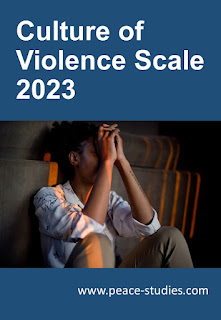Это автоматический перевод. Пожалуйста, извините за любые ошибки.
Франц Едличка (Franz Jedlicka), родившийся в Вене, австрийский социолог и
исследователь мира. Первоначально он исследовал негативное
влияние широко распространенного насилия в воспитании детей
на миролюбие отдельных стран.
Шкала культуры насилия (Culture of Violence Scale):
Позже он также исследовал другие формы насилия (например,
в отношении женщин, смертную казнь, пытки), используя
международные данные, и составил из них шкалу, измеряющую
степень культуры насилия в странах по всему миру: «Шкалу
культуры насилия». Результатом этого исследования является
то, что только те страны начинают войны или вооруженные
конфликты, в которых многие формы насилия уже были приняты,
поскольку они не запрещены законом. Подробно, люди,
ответственные за войну, почти всегда являются политическими
деятелями, которые сами испытали насилие в этих культурах.
Связь между законодательством и миром (Legislation-Peace Nexus):
Для Едлички вывод из этого исследования заключается в том, что
страны, которые хотят стать более миролюбивыми или укрепить
свое миролюбие в отношении глобального мира, должны
запретить все формы насилия законом, особенно телесные
наказания детей (SDG 16.2). Это «связь законодательства
и мира», которую также следует учитывать в политике развития,
а именно в отношении «тройной связи» («связь HDP»).
Стратегия внедрения принципов мира (Peace Mainstreaming):
Однако ненасильственное разрешение конфликтов должно
практиковаться во всех сферах общества: Едличка называет
это стратегией «внедрения мира». Равенство женщин, а также
уважение всех прав человека также играют ключевую роль
в этой стратегии. В то же время страны, которые хотят стать
более миролюбивыми или укрепить свое миролюбие, должны
практиковать методы поощрения эмпатии. Они в первую очередь
включают различные возможности для людей обсуждать вещи
друг с другом, чтобы лучше понимать друг друга. Подходящие
методы для этого включают «ненасильственное общение»
(Маршалл Б. Розенберг), «круги эмпатии», «совместное
консультирование» и встречи для пожилых людей, чтобы
поделиться своими воспоминаниями. Психологические
дискуссионные группы особенно важны в травмированных
странах, где диалог должен помочь пережить пережитые
страдания, чтобы предотвратить их повторение или передачу
следующему поколению.
Избегание насилия в СМИ также является частью стратегии
«мирного мейнстриминга», как и поощрение мирной мужественности
посредством мер, которые способствуют заботливой, чуткой
мужественности. Например, через отпуск по уходу за ребенком
для отцов и продвижение мужчин в социальных профессиях и
карьере в секторе здравоохранения. Обязательный социальный
год для молодых людей после окончания школы также может
сделать общество более чутким.
Данная статья может быть также опубликована в других
СМИ при условии сохранения ее содержания и указания автора:
(Licensed under CC BY-ND 4.0. To view a copy of this license, visit https://creativecommons.org/licenses/by-nd/4.0/ )




